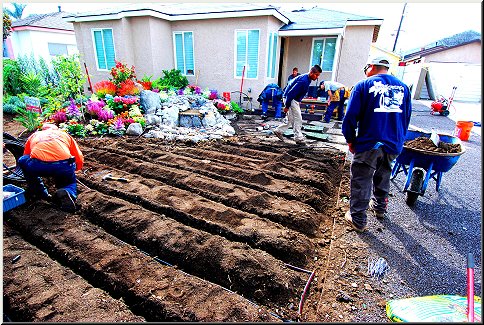Subsurface Drip Irrigation Under Grass for Your Landscape: Enviroscape LA
As Southern California endures its worst drought ever, many conservation measures are being enacted to ensure our environmental future. A large movement is happening, which, in a nutshell, tells us to remove grass/lawns and replace these with native plants. Somehow, the grass is now the enemy of the landscape. While there are merits to removing a lawn, there are also benefits that come with having a lawn.

If you have kids or dogs, a lawn is a must. Some will say, “Go to the park,” if the dog needs grass. I believe it’s important for homeowners to decide which is the best course for them to take. Lawns require more water than native plants. However, have you tried to play a game of soccer or football on top of native plants? Lawns are a must in some circumstances (kids and dogs). My job is not to tell you what to do; however, my responsibility is to inform you of better choices if you decide to keep your grass.
Subsurface or underground sprinkler systems just make sense. What is subsurface drip irrigation? It is tubing that is trenched about 3”–4” below the grass surface and covered over with grass seed. When the system comes on, the grassroots are watered.
Do grass blades need to get watered? No. The goal of irrigation is to get water to the roots of a plant. Drip irrigation is the world’s most efficient type of irrigation and waters only the root system. It came from Israel (where water is practically worth as much as gold) and was invented about 50 years ago.
One problem with drip irrigation in the past was root intrusion and blockage. When an underground drip was installed in the grass, roots would attempt and sometimes succeed in plugging the drip outlet holes, resulting in dead grass. The remedy? Herbicides! Since herbicides are poisonous and damage our environment, this was not a good choice, so there was resistance to installing this type of product in the ground. All of this changed in 2010. The world’s largest sprinkler manufacturer (Rainbird) came out with a new product. Everyone wondered why Rainbird had not released a subsurface drip product before. The reason? They did not want to make “just another product” to go into the ground. Their sensitivity to the environment forced them to ask a better question. How can we make subsurface drip irrigation for grass, which does not need to inject harmful herbicides into our environment?
They tested many methods, and after years of testing one particular product, they found the answer. This is their XF-SDI Series Dripline. It has proven to be effective, reliable, and environmentally friendly. It is the world’s only sustainable subsurface drip irrigation.
How do they keep roots from blocking the drip tubing? They invented a technology called “Copper Shield,” which protects emitters from root intrusion. Copper pipe is how water is delivered to our homes. The use of copper in Rainbird drip irrigation is safe. Underground watering saves water as you are reaching your direct target.
Subsurface drip is unaffected by wind and evaporation, resulting in 70% water saved over conventional overhead sprinklers. How many times have you seen the parkway strip between the sidewalk and the street get blasted with conventional sprinklers, which resulted in water spots on your car, or overspray in the gutter, which carries oil and fertilizer chemicals to our ocean, thus polluting our ocean? Have you slipped or fallen due to wet sprinkler conditions? How about the green algae ring on your house or fence, which is caused by sprinkler overspray? All these problems disappear with the installation of subsurface drip irrigation.
What good is saving water if it’s at the cost of our environment? Rainbird is both saving water AND taking a serious stand in favor of our environment. Their XF-SDI Dripline is the ONLY truly green, sustainable drip irrigation in the market. How do you fertilize a lawn when you use a subsurface drip? You must use a liquid fertilizer that transfuses directly into the irrigation system, called “fertigation.”